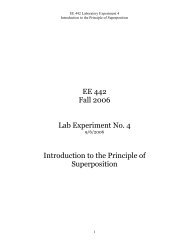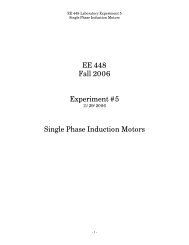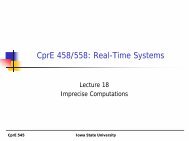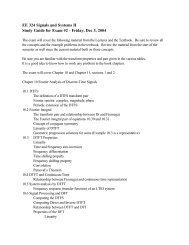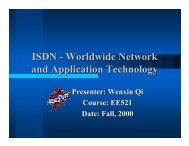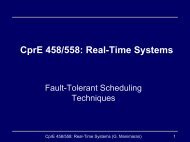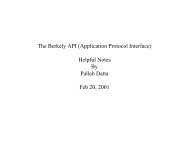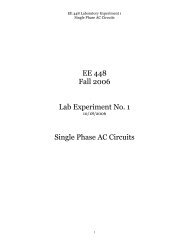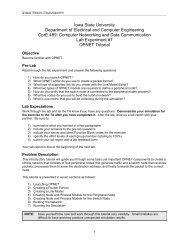Power Control and RAKE Receiver - Iowa State University
Power Control and RAKE Receiver - Iowa State University
Power Control and RAKE Receiver - Iowa State University
Create successful ePaper yourself
Turn your PDF publications into a flip-book with our unique Google optimized e-Paper software.
IS-95 St<strong>and</strong>ard-<strong>Power</strong> <strong>Control</strong> <strong>and</strong> <strong>RAKE</strong> <strong>Receiver</strong>Robert Volesky<strong>Iowa</strong> <strong>State</strong> <strong>University</strong> EE 521Robert Volesky 29 Nov 001
Overview• IS-95 st<strong>and</strong>ard for cellular• Mobile propagation environment• <strong>Power</strong> control in IS-95• <strong>RAKE</strong> receiver in IS-95<strong>Iowa</strong> <strong>State</strong> <strong>University</strong> EE 521Robert Volesky 29 Nov 002
IS-95 St<strong>and</strong>ard• Direct Sequence CDMA• Developed by Qualcomm to replace IS-54 TDMAst<strong>and</strong>ard in early 1990’s• TIA (Telecommunications Industry Association)TR45.5 committee• Features– 42-bit maximal-length sequence– Universal frequency reuse, cells, <strong>and</strong> sectoring (N=1)– <strong>RAKE</strong> receivers– Low average power, longer battery life<strong>Iowa</strong> <strong>State</strong> <strong>University</strong> EE 521Robert Volesky 29 Nov 003
IS-95 St<strong>and</strong>ardB<strong>and</strong>widthChip RateFrequency b<strong>and</strong> uplinkFrequency b<strong>and</strong> downlinkFrame lengthSoft h<strong>and</strong>over<strong>Power</strong> controlNumber of <strong>RAKE</strong> fingersSpreading codes1.25 MHz1.2288 Mc/s869-894 MHz1930-1980 MHz824-849 MHz1850-1910 MHz20 msYesUplink: open loop + fast closed loopDownlink: slow quality loop4Walsh+Long M-sequence<strong>Iowa</strong> <strong>State</strong> <strong>University</strong> EE 521Robert Volesky 29 Nov 004
<strong>Power</strong> <strong>Control</strong> in IS-95• Need for power control• Reverse link (Mobile-to-Base)– Open loop–Closed loop• Forward link (Base-to-Mobile)<strong>Iowa</strong> <strong>State</strong> <strong>University</strong> EE 521Robert Volesky 29 Nov 006
Need for <strong>Power</strong> <strong>Control</strong> in IS-95• All CDMA signals interfere with one another– Near-orthogonal codes make other users appear asinterference noise at the receiver– High transmitted power levels of mobiles near the baseraise noise level at base (Near-far problem)• Multipath fading channel• Prolong battery life– Smallest level possible to maintain quality– Maximize capacity <strong>and</strong> increase talk-time<strong>Iowa</strong> <strong>State</strong> <strong>University</strong> EE 521Robert Volesky 29 Nov 007
Reverse Link Open Loop <strong>Power</strong> <strong>Control</strong>• Used during mobile’s access attempts• Determine power level to transmit “accessprobe” based on total power received frombase station(s)• Update power level if probe unsuccessful• Wait r<strong>and</strong>om time before transmitting next“access probe”<strong>Iowa</strong> <strong>State</strong> <strong>University</strong> EE 521Robert Volesky 29 Nov 008
Reverse Link Open Loop <strong>Power</strong> <strong>Control</strong><strong>Iowa</strong> <strong>State</strong> <strong>University</strong> EE 521Robert Volesky 29 Nov 009
Reverse Link Closed Loop <strong>Power</strong> <strong>Control</strong>• Begins once access is given to mobile• Separation of forward <strong>and</strong> reverse link by 45 MHz– Reverse channel characteristics are not stronglycorrelated to forward channel characteristics• Tight power control needed– <strong>Power</strong> level updated at 800 bps (1.25ms)– Attempts to maintain E b /I t at base– <strong>Power</strong> control subchannel uses puncturing techniquesto transmit ‘1’ or ‘0’ to mobile to raise or lower itspower level<strong>Iowa</strong> <strong>State</strong> <strong>University</strong> EE 521Robert Volesky 29 Nov 0010
Reverse Link Closed Loop <strong>Power</strong> <strong>Control</strong><strong>Iowa</strong> <strong>State</strong> <strong>University</strong> EE 521Robert Volesky 29 Nov 0011
Forward Link <strong>Power</strong> <strong>Control</strong>• Slow quality loop– Not as critical to have tight power control onforward link• Based on frame error rates at mobile<strong>Iowa</strong> <strong>State</strong> <strong>University</strong> EE 521Robert Volesky 29 Nov 0012
Forward Link <strong>Power</strong> <strong>Control</strong><strong>Iowa</strong> <strong>State</strong> <strong>University</strong> EE 521Robert Volesky 29 Nov 0013
Time Diversity <strong>and</strong> <strong>RAKE</strong><strong>Receiver</strong>• Time diversity combines replicas of transmittedsignal to improve signal quality• In DS-CDMA, multipath creates identical versionsof transmitted signal• Due to low correlation of time delayed signals(appear as noise), IS-95 combines the delayedsignals together using a <strong>RAKE</strong> receiver• Necessary to have an adaptive <strong>RAKE</strong> receiver– Continuously estimates the power <strong>and</strong> delay ofmultipath signals<strong>Iowa</strong> <strong>State</strong> <strong>University</strong> EE 521Robert Volesky 29 Nov 0014
<strong>RAKE</strong> <strong>Receiver</strong><strong>Iowa</strong> <strong>State</strong> <strong>University</strong> EE 521Robert Volesky 29 Nov 0015
IS-95 <strong>RAKE</strong> <strong>Receiver</strong>• Chipping rate of 1.2288 Mcps allows amultipath resolution of 0.814 μs• Forward link – 3-finger <strong>RAKE</strong> receiver• Reverse link – 4-finger <strong>RAKE</strong> receiver• “Searcher <strong>Receiver</strong>” programmed to finddelay <strong>and</strong> amplitudes of multipath signals• Used for communication with more thanone base station in soft h<strong>and</strong>off<strong>Iowa</strong> <strong>State</strong> <strong>University</strong> EE 521Robert Volesky 29 Nov 0016
Conclusions• Use of <strong>RAKE</strong> receiver together with tightpower control gave Qualcomm a solution tosome of the problems faced by DS-CDMA• IS-95 became a successful cellular st<strong>and</strong>ard<strong>Iowa</strong> <strong>State</strong> <strong>University</strong> EE 521Robert Volesky 29 Nov 0017
References• [1] QUALCOMM Incorporated. Answers to Questions for all Presenters. 1992.• [2] Steele, Raymond. “The Evolution of Personal Communications.” IEEE Personal CommunicationsMagazine. Second Quarter 1994, Volume 1, Number 2. Online. Accessed on 10 May 2000.http://www.comsoc.org/pubs/surveys/steele/steele-orig.html• [3] Prasad, Ramjee <strong>and</strong> Tero Ojanperä. “An Overview of CDMA Evolution toward Wideb<strong>and</strong> CDMA.” IEEECommunications Surveys. 1998 Online. Accessed on 7 May 2000.http://www.comsoc.org/pubs/surveys/4q98issue/prasad.html• [4] Rappaport, Theodore S. Wireless Communications: Principles <strong>and</strong> Practice. Upper Saddle River, NJ:Prentice Hall. 1996.• [5] QUALCOMM Incorporated. “Presentation of CDMA to the 1 st CTIA Wideb<strong>and</strong>/Spread Spectrum OpenForum.” San Diego. 17 March 1992.• [6] Larson, L.; Asbeck, P.; Hanington, G.; Chen, E.; Jayamaran, A.; Langridge, R.; Xuejun Zhang. “Device <strong>and</strong>circuit approaches for improved wireless communications transmitters.”IEEE Personal Communications, Volume: 6 Issue: 5, Oct. 1999. Pages 18–23.• [7] “<strong>Power</strong> <strong>Control</strong> Methods: The Mobile Environment.” Online. Accessed on 20 Nov 2000.http://www.amug.org/~ahmrphd/<strong>Power</strong><strong>Control</strong>.html• [8] Garg, Vijay K. IS-95 CDMA <strong>and</strong> cdma2000. Upper Saddle River, NJ: Prentice Hall. 2000.• [9] Nikolai, D.; Kammeyer, K.-D. “Noncoherent <strong>RAKE</strong>-receiver with optimum weighted combining <strong>and</strong>improved closed-loop power control.” Spread Spectrum Techniques <strong>and</strong> Applications Proceedings, 1996,Volume: 1, 1996. Pages: 239 –243.• [10] Donegan, Patrick. “IS-95 CDMA Becomes a World St<strong>and</strong>ard.” CDMA Spectrum. CDMA One, June1997. Online. Accessed on 10 May 2000. http://www.cdg.org/library/spectrum/Jun97/article4_int.html<strong>Iowa</strong> <strong>State</strong> <strong>University</strong> EE 521Robert Volesky 29 Nov 0018
Questions?<strong>Iowa</strong> <strong>State</strong> <strong>University</strong> EE 521Robert Volesky 29 Nov 0019



